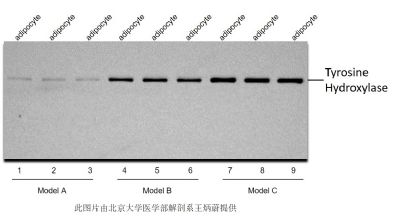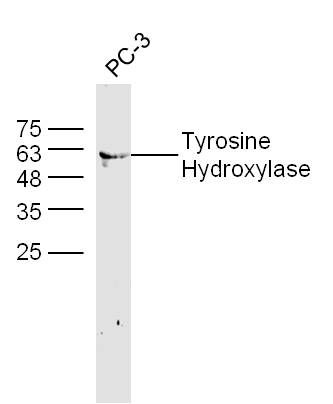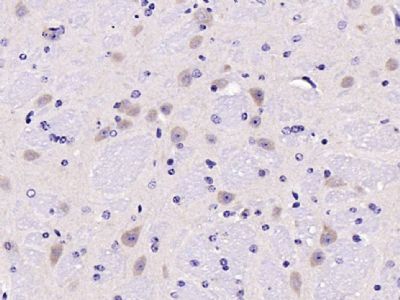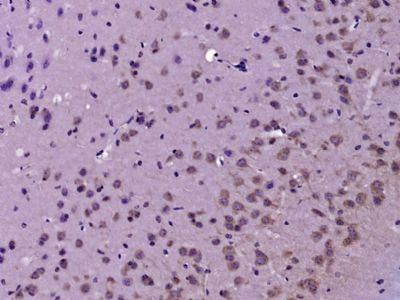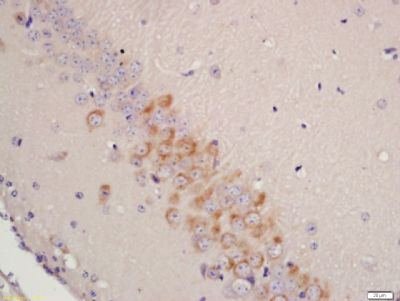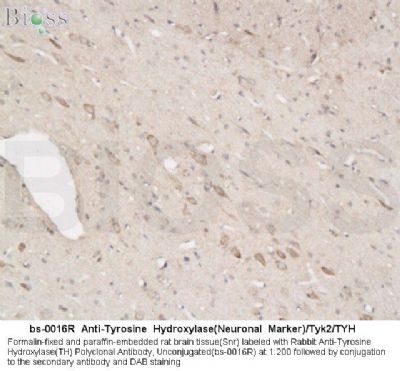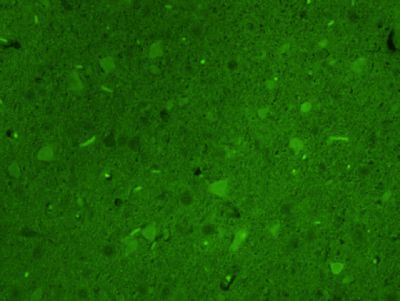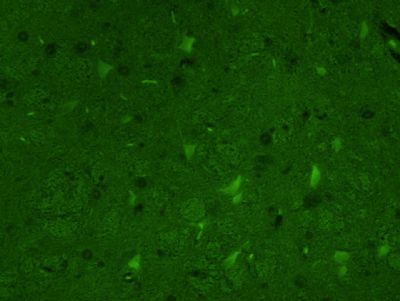Sample: adipocyte (mouse) Lysate at 5-10 ug
model A, model B, model C are from different mice; Primary: Anti-Tyrosine Hydroxylase(SL0016R) at 1/2000 dilution
Predicted band size: 60 kD
Observed band size: 60 kD
Sample: PSLC3 (Mouse) Lysate at 30 ug
Primary: Anti-Tyrosine Hydroxylase (SL0016R) at 1:300 dilution;
Secondary: HRP conjugated Goat-Anti-rabbit IgG(SL0295G-HRP) at 1:5000 dilution;
Predicted band size:60 kD
Observed band size:60 kD
Paraformaldehyde-fixed, paraffin embedded (mouse brain); Antigen retrieval by boiling in sodium citrate buffer (pH6.0) for 15min; Block endogenous peroxidase by 3% hydrogen peroxide for 20 minutes; Blocking buffer (normal goat serum) at 37°C for 30min; Antibody incubation with (Tyrosine Hydroxylase) Polyclonal Antibody, Unconjugated (SL0016R ) at 1:200 overnight at 4°C, followed by operating according to SP Kit(Rabbit) (sp-0023) instructionsand DAB staining.
Paraformaldehyde-fixed, paraffin embedded (Mouse brain); Antigen retrieval by boiling in sodium citrate buffer (pH6.0) for 15min; Block endogenous peroxidase by 3% hydrogen peroxide for 20 minutes; Blocking buffer (normal goat serum) at 37°C for 30min; Antibody incubation with (Tyrosine Hydroxylase) Polyclonal Antibody, Unconjugated (SL0016R) at 1:400 overnight at 4°C, followed by operating according to SP Kit(Rabbit) (sp-0023) instructionsand DAB staining.
Tissue/cell: rat brain tissue; 4% Paraformaldehyde-fixed and paraffin-embedded;
Antigen retrieval: citrate buffer ( 0.01M, pH 6.0 ), Boiling bathing for 15min; Block endogenous peroxidase by 3% Hydrogen peroxide for 30min; Blocking buffer (normal goat serum,SLC0005) at 37℃ for 20 min;
Incubation: Anti-Tyrosine Hydroxylase Polyclonal Antibody, Unconjugated(SL0016R) 1:200, overnight at 4°C, followed by conjugation to the secondary antibody(SP-0023) and DAB(SLC0010) staining
Paraformaldehyde-fixed, paraffin embedded (Rat brain); Antigen retrieval by boiling in sodium citrate buffer (pH6.0) for 15min; Block endogenous peroxidase by 3% hydrogen peroxide for 20 minutes; Blocking buffer (normal goat serum) at 37°C for 30min; Antibody incubation with (Tyrosine Hydroxylase) Polyclonal Antibody, Unconjugated (SL0016R) at 1:400 overnight at 4°C, followed by a conjugated secondary antibody (SL0295G-FITC) for 90 minutes, and DAPI for nuclei staining.
Paraformaldehyde-fixed, paraffin embedded (Mouse brain); Antigen retrieval by boiling in sodium citrate buffer (pH6.0) for 15min; Block endogenous peroxidase by 3% hydrogen peroxide for 20 minutes; Blocking buffer (normal goat serum) at 37°C for 30min; Antibody incubation with (Tyrosine Hydroxylase) Polyclonal Antibody, Unconjugated (SL0016R) at 1:400 overnight at 4°C, followed by a conjugated secondary antibody (SL0295G-FITC) for 90 minutes, and DAPI for nuclei staining.
|
